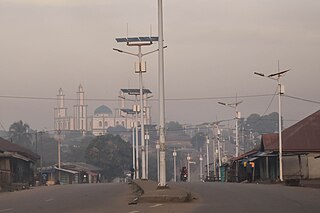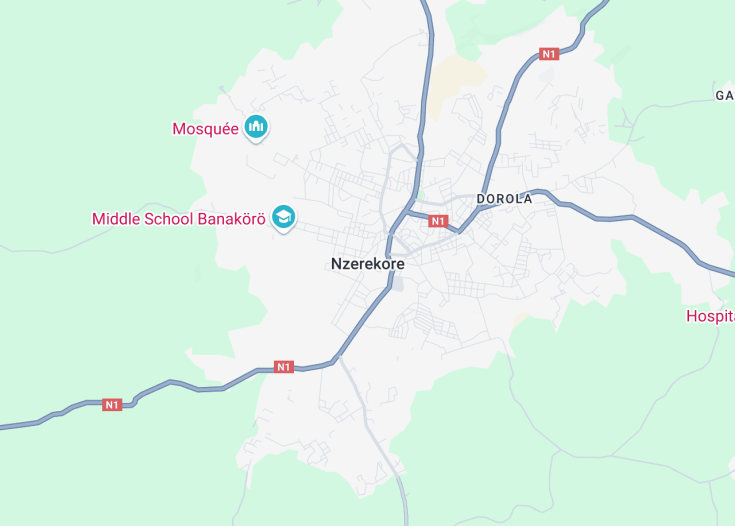Nzérékoré, nestled in the lush, forested region of Guinea, stands as a captivating destination rich in cultural diversity and natural splendor. This city, often referred to as the gateway to the Guinea Highlands, offers a unique glimpse into traditional West African life. Visitors can explore local markets brimming with vibrant handicrafts, delve into the history of indigenous peoples at cultural centers, and partake in colorful festivals that showcase the spirited heritage of the region. Nzérékoré also serves as a prime starting point for adventurous treks into the surrounding highland areas, where dense forests and hidden waterfalls await.
Ensure to visit during a cultural festival to experience Nzérékoré in its full vibrancy, enjoying the fusion of music, dance, and local tradition.
For a truly immersive experience, consider a guided tour into the nearby forests. The insights provided by knowledgeable locals can greatly enrich your visit.
Nzérékoré: Gateway to the Guinean Highlands
| Country | Guinea |
| Time in Nzérékoré | GMT-0 |
| Language spoken | French |
| Population | 400,000 (Source: World Population Review) |
| Currency | Guinean franc (GNF, FG) |
| Airports |
|
Located in the forest region of southern Guinea, Nzérékoré is the economic and transportation hub of the country’s southeastern part. As the second-largest city in Guinea, it plays a critical role in regional trade and cultural exchanges within the Mano River Union countries. Historically, Nzérékoré has been at the crossroads of rich cultural interactions, hosting a diverse population comprising different ethnic groups such as the Kpelle, Toma, and Guerzé. The city’s vibrant markets, where traditional handicrafts alongside modern goods are sold, exemplify its dynamic cultural tapestry.
Where is Nzérékoré?
Located near the borders of Liberia and Côte d’Ivoire, Nzérékoré is nestled in the heart of the Guinea Highland.
Distances:
| Route | Distance by car | Time by car |
|---|---|---|
| Conakry to Nzérékoré | 555 miles (893 km) | Approx. 12 hours |
| Kankan to Nzérékoré | 295 miles (475 km) | Approx. 7 hours |
What is Nzérékoré famous for?
Nzérékoré is known for its rich cultural diversity, bustling markets, and as a starting point for visits to the surrounding rainforest-rich regions, featuring an abundance of West African wildlife.
History
Pre-Colonial Times – Before 19th Century
Nzérékoré, located in the Forest Region of Guinea, has been a vibrant hub long before colonial times, primarily inhabited by the Guerzé people, also known as the Kpelle. The region’s abundant rainfall and fertile soil made it an ideal location for agriculture and settlement. Combatting isolation due to its dense forest surroundings, the indigenous communities established a self-reliant society largely based on subsistence farming, hunting, and later, trade with neighboring regions.
Colonial Era – 19th Century to 1958
With the onset of European exploration and subsequent colonization, Nzérékoré became part of French Guinea. During this period, French influence permeated through the establishment of administrative offices, the introduction of cash crops, and the expansion of trade routes which linked Nzérékoré with other parts of Guinea and neighboring Liberia and Cote d’Ivoire. Infrastructure improvements, such as roads and railways, were introduced, which significantly altered the social and economic landscape of the area.
Post-Independence Period – 1958 to Present
Following Guinea’s independence in 1958, Nzérékoré transitioned from a colonial outpost to a key player in the nation’s development. It has since become Guinea’s second-largest city and an important economic center, particularly in terms of agriculture, with its markets busting with the produce such as coffee, palm oil, and fruits. Politically and socially, it has been a focal point for ethnic diversity and sometimes tension, housing multiple ethnic groups including the Kpelle, Mandinka, and Fulani. Despite past conflicts, nowadays Nzérékoré is a melting pot of cultures and traditions, progressing while retaining its unique cultural heritage.
Visit Nzérékoré
What to see and do in Nzérékoré
Discover the enchanting city of Nzérékoré, nestled in Guinea’s lush Forest Region. Visitors can explore local cultural sites such as the Grand Mosque and the Cathedral of Sainte-Anne, significant not only for their religious import but for their distinctive architectural styles. The Ethnographic Museum provides insights into the local Guerzé culture and history, making it a must-visit.
- Explore the bustling local markets like Nzérékoré Market, where you can experience local life and purchase traditional crafts.
- Visit nearby Mount Nimba Strict Nature Reserve, a UNESCO World Heritage site, for breathtaking natural landscapes and diverse wildlife.
- Engage with local communities to learn more about the indigenous Guerzé culture through immersive experiences.
Festive Nzérékoré
Nzérékoré vibrates with cultural festivals and events, most notably the annual Nzérékoré Cultural Festival, held typically in the dry season between December and February. This event showcases traditional music, dance, and customs of the region, drawing participants and spectators from across Guinea and beyond to celebrate the rich heritage of the Forest Region.
Best time to visit Nzérékoré
The ideal time to visit Nzérékoré is during the dry season, from November to April, when the weather is more temperate and roads are accessible. This period also coincides with local cultural events and festivals which provide a deeper glimpse into the region’s traditions and community life.
Is Nzérékoré worth visiting?
Nzérékoré offers a unique blend of ethnic diversity, cultural richness, and natural beauty, making it an intriguing destination for those interested in exploring beyond typical tourist paths. However, its appeal might be tempered by logistical challenges including limited tourism infrastructure and occasional social tensions. Regardless, for the adventurous traveler, the authentic interactions and explorations of Guinea’s lush landscape and vibrant cultural fabric can be immensely rewarding. Nzérékoré is certainly a destination with the potential to provide enriching experiences for those willing to venture into its depths.









